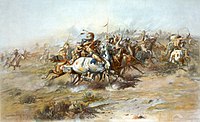Portal:Indigenous peoples of the Americas/Selected article/11

The Battle of the Little Bighorn, commonly referred to as Custer's Last Stand, was an armed engagement between combined forces of the Lakota, Northern Cheyenne, and Arapaho tribes, against the 7th Cavalry Regiment of the United States Army. The battle, which occurred June 25–26, 1876, near the Little Bighorn River in eastern Montana Territory, was the most prominent action of the Great Sioux War of 1876. It was an overwhelming victory for the Lakota, Northern Cheyenne, and Arapaho, led by several major war leaders, including Crazy Horse and Chief Gall, inspired by the visions of Sitting Bull (Tȟatȟáŋka Íyotake). The U.S. 7th Cavalry, including the Custer Battalion, a force of 700 men led by George Armstrong Custer, suffered a severe defeat. Five of the 7th Cavalry's twelve companies were annihilated; Custer was killed, as were two of his brothers, a nephew, and a brother-in-law. The total U.S. casualty count, including scouts, was 268 dead and 55 injured.
